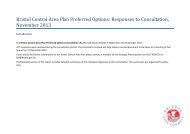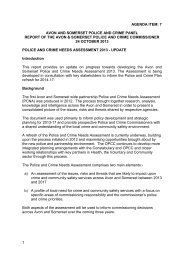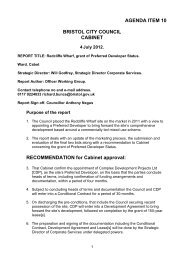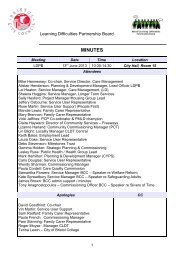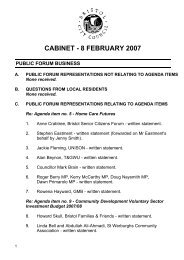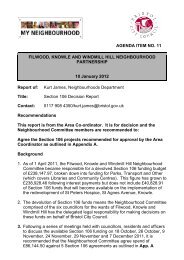uhbt quality account
uhbt quality account
uhbt quality account
You also want an ePaper? Increase the reach of your titles
YUMPU automatically turns print PDFs into web optimized ePapers that Google loves.
AGENDA ITEM NO: 10<br />
Quality Report<br />
2012/13<br />
20
AMBITIONS FOR QUALITY<br />
“We will ensure that our services are consistently safe, deliver outcomes that<br />
match the best in Europe and offer an experience that is perceived by our<br />
patients and staff to be the best it possibly could be”<br />
UH Bristol Clinical Services Strategy 2010-2015<br />
“We must make the <strong>quality</strong> of care as important as the <strong>quality</strong> of treatment. This<br />
means celebrating and spreading excellence in care; it means challenging<br />
mediocrity…; and above all, it means protecting patients and people who use<br />
services from avoidable harm. ”<br />
The Rt Hon Jeremy Hunt MP Secretary of State for Health (Government response to Francis Report, March 2013)
HSMR<br />
22
SHMI<br />
22
INFECTION CONTROL – C Difficile<br />
INFECTION CONTROL CONTEXT<br />
Good assurance that there are no systemic issues at FT<br />
Evidence<br />
• C Diff trend reduction (see graph)<br />
• C Diff within annual target<br />
• Antibiotic prescribing compliance at Trust target (90%)<br />
• Norovirus outbreak management<br />
• Results of monthly audits of key clinical <strong>quality</strong> indicators<br />
(NB audit frequency goes weekly if below target) - see table<br />
below.<br />
Key clinical <strong>quality</strong> indicators – latest audit results<br />
Indicator Dec-12 Jan-13<br />
Saving Lives Care bundle*: range 95%-100% 95%-100%<br />
Cleanliness audits: Trust score 95% 95%<br />
Hand hygiene: Trust score 96% 97%<br />
Matron checklist: Trust score 95% 95%<br />
* High Impact Interventions 1 - 6 in all inpatient areas<br />
Infection prevention & control leadership 2012/13<br />
i. Medical DIPC (up to 4 PA Consultant Microbiologist)<br />
ii. F/T Senior Infection Control nurse / deputy DIPC<br />
iii. Chief Nurse executive leadership<br />
iv. IC reporting to Medical Director-chaired Clinical Quality<br />
Grp<br />
v. Deputy Chief Nurse operational IC responsibility (weekly<br />
performance meetings)<br />
vi. 1 PA Consultant decontamination lead<br />
vii. Matron personal objectives linked to IC Plan<br />
viii. Supervisory ward sister KPIs include IC targets<br />
21
INFECTION CONTROL – MRSA<br />
2012/13 OPERATING PLAN<br />
• No significant risk identified in Annual Plan.<br />
• Steady reduction in MRSA bacteraemia cases over previous 5<br />
years (see graph)<br />
ISSUES<br />
i. Detailed root cause analysis of each case (but low numbers<br />
inhibit trend analysis)<br />
ii. Cases included IV drug users (x2) & frail older people<br />
iii. No pattern of wards, departments or sites<br />
iv. Comparison of 8 cases highlighted issue of IV line insertion<br />
and maintenance in 6 cases<br />
v. Successful improvement trend in previous years reduced<br />
operational focus on intravenous line care as key infection<br />
control issue<br />
FORECAST<br />
• Zero tolerance<br />
RECOVERY PLAN<br />
Action plan developed August 2012 after 4 th case in year<br />
Recovery plan developed December 2012 after 8 th case<br />
Actions taken to date:<br />
• Point prevalence audits of IV lines in Dec 12 and Feb 13 (covering<br />
800+ inpatients in 49 clinical areas) and showing significant<br />
improvement<br />
• External review by Infection Control lead from Plymouth<br />
• DIPC visit to GSTT<br />
Continuing approach:<br />
• Micromanagement of daily practice in care of IV lines with specific<br />
responsibilities assigned to named leads<br />
• Comprehensive approach to all IV line infections, not just MRSA<br />
• Bi-monthly point-prevalence audits of intravenous line use<br />
• Trust-wide review of infection control policies and training<br />
22
INPATIENT FALLS<br />
ISSUES<br />
i. A half to one third of patients falling have a<br />
degree of cognitive impairment, with 75% of<br />
falls occurring in patients aged 65 and over.<br />
ii. The majority of falls are not witnessed<br />
iii. A significant number of falls occur in the early<br />
hours of the morning<br />
iv. Not all falls can be prevented<br />
ACTION PLAN<br />
•A pilot project based on the Fallsafe Care Bundles and resources to reduce inpatient falls by the Royal College of Physicians (RCP<br />
2012) was undertaken across 3 wards. Thee project was commenced in November 2012 and ended in February 2013. The data<br />
generated by the project has resulted in some encouraging results with a reduction in falls in two of the areas during the pilot stage. An<br />
evaluation of project is available, with clear recommendations to take forward.<br />
•A Falls Assistant has been appointed to support the implementation of the project.<br />
•Cohorting patients at high risk of falling<br />
•Falling star magnet<br />
•Posters reminding patients to ring for help<br />
•Leaflets for patients, relatives and visitors<br />
•Identifying patients who may need to be woken at night<br />
FORECAST<br />
• Continued reduction in all avoidable hospital inpatient falls<br />
22
HOSPITAL ACQUIRED PRESSURE ULCERS<br />
External Review (August 2012) identified priority areas:<br />
• Equipment, including storage<br />
• Role of the Tissue Viability Team<br />
• Education and training<br />
ISSUES<br />
The core themes emerging from the Root Cause Analyses<br />
are:<br />
• Incorrect categorisation/grading during admission,<br />
indicating the need for further education and training.<br />
• Inconsistent practice with regard to care rounding<br />
and documentation.<br />
• Further analysis undertaken shows a close link to<br />
poor nutrition and sepsis.<br />
• An emerging link is the time spent on the floor/bed<br />
bound pre-admission, or on a trolley and the<br />
development of a pressure ulcer within 24-48 hours.<br />
FORECAST<br />
A continued reduction of hospital acquired pressure ulcers.<br />
Zero tolerance to grade 3 and 4<br />
ACTION PLAN (developed September 2012)<br />
Actions taken to date:<br />
• Temporary Mattress store refurbished and open. Staff member appointed<br />
to support the running of the store to ensure mattresses available when<br />
needed<br />
• New beds and mattresses purchased. Formation of a Beds and Mattresses<br />
Group<br />
• Buffer stocks of mattresses available for use out of hours.<br />
• Team reviewing all grade 2 pressure ulcers and above with ward staff<br />
• Virtual patient interactive teaching programme developed with the<br />
University of the West of England<br />
• External visits to other Trusts<br />
• Senior nursing focus and leadership to maintain momentum, ensure staff<br />
engagement and reduce the incidence of hospital acquired pressure<br />
ulcers.<br />
22
QUALITY OBJECTIVES 2012/13<br />
Achieved / targets met<br />
• Reductions in medication errors<br />
• Improvements in nutritional care<br />
• Histopathology clinical audit programme<br />
• Development of enhanced recovery<br />
• Implementation of NHS Safety Thermometer<br />
• Implementation of patient experience and involvement strategy<br />
• Implementation of dementia action plan<br />
• Incidence of discrimination against staff, as reported in the NHS Staff Survey
QUALITY OBJECTIVES 2012/13<br />
Partially achieved<br />
• Progress in participation in NHS South West Quality & Safety Programme<br />
• Volume of complaints, and response times<br />
• Proportion of patients who felt they had been treated with kindness and<br />
understanding<br />
• Ensuring patients know who to speak to if they have worries or concerns<br />
• Patient-reported noise at night from staff<br />
• Risk assessment of patients with a learning disability<br />
• Demonstrating compliance with NICE Guidance
QUALITY OBJECTIVES 2012/13<br />
Underachieved<br />
• Patient falls<br />
• Pressure ulcers<br />
• Proportion of stroke patients cared for on a dedicated stroke ward (stretch<br />
target)<br />
• Developing use of service-specific standardised mortality ratios
QUALITY OBJECTIVES 2012/13<br />
Data awaited<br />
• Communication with patients about waiting times in clinic<br />
• Outcomes of gynaecological surgery
QUALITY OBJECTIVES 2013/14<br />
Patient safety<br />
• Increase harm-free care as measured via the NHS Safety Thermometer<br />
• Reduce medication errors<br />
• Extend medicines reconciliation (‘getting the medicines right’)<br />
• Improve the early identification and escalation of care of deteriorating patients<br />
• Improve levels of nutritional screening and 72 hour nutritional review
QUALITY OBJECTIVES 2013/14<br />
Patient experience<br />
• Ensure that patients are treated with kindness and understanding<br />
• Implement the NHS Friends and Family Test<br />
• Explain medication side effects to inpatients when they are discharged
QUALITY OBJECTIVES 2013/14<br />
Clinical effectiveness<br />
• Ensure that patients with an identified special need, including those with a<br />
learning disability, have a risk assessment and patient-centred care plan<br />
• Ongoing implementation of dementia action plan<br />
• Achieve best practice tariff for hip fractures<br />
• Ensure patients with diabetes have access to specialist diabetic support<br />
• Baseline review of available clinical outcome data
Questions?<br />
20



